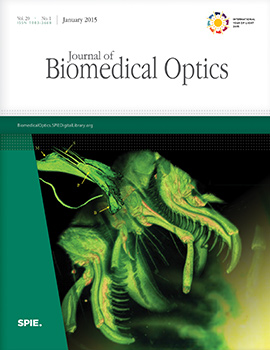Bálint Botz, Kata Bölcskei, Ágnes Kemény, Zoltán Sándor, Valéria Tékus, György Sétáló Jr., Janka Csepregi, Attila Mócsai, Erika Pintér, László Kollár, Zsuzsanna Helyes
Journal of Biomedical Optics, Vol. 20, Issue 01, 016022, (January 2015) https://doi.org/10.1117/1.JBO.20.1.016022

TOPICS: In vivo imaging, Luminescence, Plasma, Inflammation, Near infrared, Ear, Biomedical optics, Confocal microscopy, Animal model studies, Proteins
Vascular leakage is an important feature of various disease conditions. In vivo optical imaging provides a great opportunity for the evaluation of this phenomenon. In the present study, we focus on the development and validation of a near-infrared (NIR) imaging formula to allow reliable, cost-efficient evaluation of vascular leakage in diverse species using the existing small-animal fluorescence imaging technology. IR-676, a moderately hydrophobic NIR cyanine dye, was doped into self-assembling aqueous micelles using a widely employed and safe nonionic emulsifier (Kolliphor HS 15), and was tested in several acute and chronic inflammatory disease models in both mice and rats. The imaging formula is stable and exerts no acute toxic effects in vitro. It accumulated specifically in the inflamed regions in all models, which could be demonstrated by both conventional epifluorescence imaging, and fluorescence tomography both as a standalone technique and also by merging it with computed tomography scans. Ex vivo verification of dye accumulation by confocal fluorescence microscopy was also possible. The present formula allows sensitive and specific detection of inflammatory plasma leakage in diverse models. Its potential for imaging larger animals was also demonstrated. IR-676-doped micelles offer an excellent opportunity to image inflammatory vascular leakage in various models and species.



 Receive Email Alerts
Receive Email Alerts